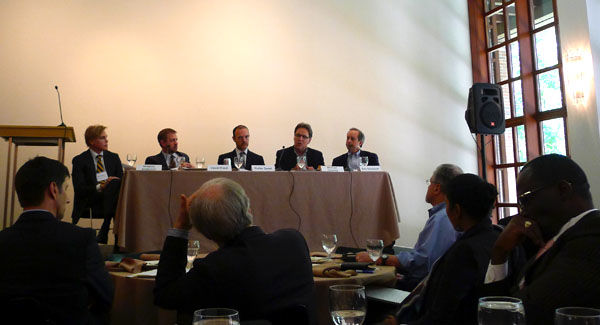Article by Gregory Andersen, Former manager, international grantmaking
The 5th Humanitarian Action Summit brought together prominent researchers and leaders from the humanitarian and development communities, international NGOs, UN agencies, federal agencies and donor organizations.

On May 13 and 14, the Harvard Humanitarian Initiative hosted its 5th Humanitarian Action Summit. This year, the event was held at the American Academy of Arts and Sciences in Boston, a beautiful and serene setting for discussions about critical issues in humanitarian aid, research, and policy. The conference brought together prominent researchers and leaders from the humanitarian and development communities, international NGOs, UN agencies, federal agencies and donor organizations.
This year, the Conrad N. Hilton Foundation sponsored a panel of experts to explore the topic of “Rethinking Humanitarian Aid.” The discussion featured Michael Delaney, Director of Humanitarian Response at Oxfam; Bob Ottenhoff, President & CEO at the Center for Disaster Philanthropy; Walter Sweet, Vice President at Rockefeller Philanthropy Advisors; and David Wood, Director of the Initiative for Responsible Investment at Harvard University.
The panel explored themes covered in the report “Philanthropic Grantmaking for Disasters: Lessons learned at the Conrad N. Hilton Foundation.” One of the key findings of the report is that the philanthropic community needs to support and promote disaster preparedness, as well as building the resilience and recovery capacity of vulnerable communities before disaster strikes.
Although there is often a lot of media attention and a big flow of assistance in the first month or two following a disaster, funding and attention and support tend to taper off rather quickly. Yet, affected communities may need support and resources for many more months or years to help them recover and rebuild. These communities need long-term resources to truly recover—not just to survive short-term.
“I think that that the most successful grantmaking organizations I’ve worked with are the ones that really use local expertise and understand the communities,” said Walter Sweet. “After disasters occur, there’s a lack of good information and a lot of misinformation on the ground, so having really good local partners makes you more effective.”
In the aftermath of Hurricane Katrina, the Hilton Foundation recognized the importance of engaging with partners on the ground and retained the services of a local consultant early on. We also chose to work very closely with community foundations to make sure we were listening to the voices of the people we were trying to assist, and we documented our experiences in two separate reports; “Response to Hurricane Katrina” and “Grantmaking for Disasters.”
Local partnerships can also help expose underlying social issues. “Natural disasters reveal that there are vulnerable populations that have been vulnerable for a long time—the poor, the elderly, the handicapped, etc.—just like in Haiti, New Orleans, and the tri-state area after Sandy,” explained Bob Ottenhoff. “Working with these vulnerable communities requires having donors who understand that these are problems that have been around for a long time and need longer-term solutions.”
David Wood added that “Disasters are now being presented to the investment community as the cost of doing business, but no one is presenting the case for resilience. Investors are trying to figure out which kinds of disasters can benefit from short-term cash infusions and which ones need long-term investments to be most effective.”
Another key discussion point was whether the humanitarian aid community can do more to involve the people they are trying to help. The general consensus was that it’s difficult to evaluate emergency operations while they’re taking place, so organizations need to take the time to reflect and regroup in times of relative calm. “It’s a question of changing the dynamic and realizing that local populations have a prominent role to play when disasters strike, not trying to figure it out in the midst of a crisis,” said Michael Delaney.
Walter Sweet added: “Some of the best examples of funding happen long after the disaster has occurred, when local populations develop community efforts. If you can involve the community in a meaningful way and give them the decision making power about how they recover, you will see much better results.”
All the speakers agreed that strengthening community organizations is important to humanitarian aid efforts. Michael Delaney mentioned the CDA Collaborative Learning Projects’ “Time to Listen: Hearing People on the Receiving End of International Aid,” a survey of international aid recipients, who overwhelmingly said that the speed of the response was not important as the local communities’ involvement.
After the panel Q and A, the discussion was opened up to the audience who asked some probing questions about practical next steps and means of implementing some of these recommendations. We hope that you will join the discussion on this page with your thoughts on how we can collectively rethink how humanitarian aid is approached. What do you think the biggest challenges currently are to providing effective disaster-related humanitarian assistance? How do you think those challenges can be addressed? What needs to happen in order to make humanitarian aid more responsive to the voice and needs of beneficiaries? What are some ways we could change the mindset from being response-oriented to being more proactively preparedness- and resilience-minded?